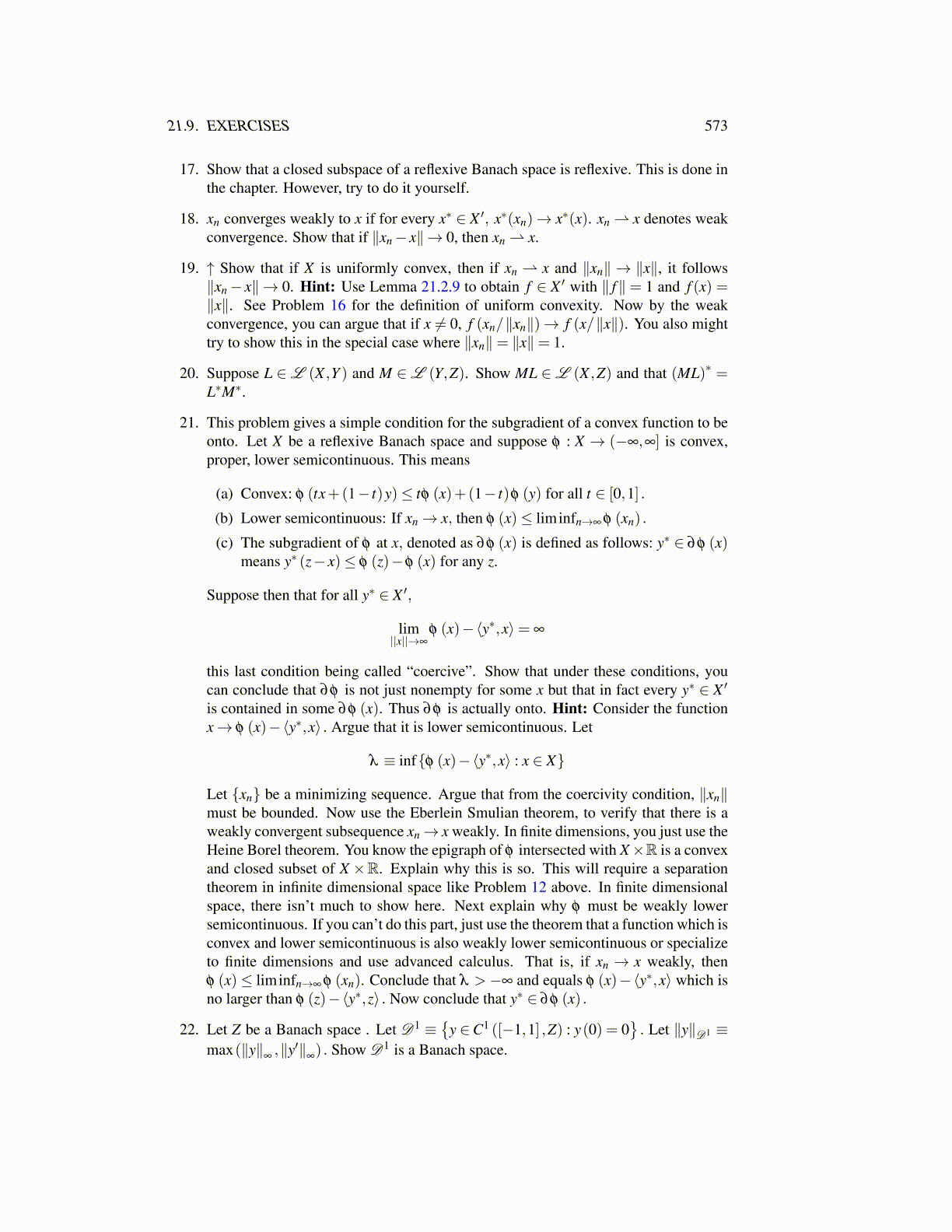
21.9. EXERCISES 573
17. Show that a closed subspace of a reflexive Banach space is reflexive. This is done inthe chapter. However, try to do it yourself.
18. xn converges weakly to x if for every x∗ ∈ X ′, x∗(xn)→ x∗(x). xn ⇀ x denotes weakconvergence. Show that if ∥xn− x∥→ 0, then xn ⇀ x.
19. ↑ Show that if X is uniformly convex, then if xn ⇀ x and ∥xn∥ → ∥x∥, it follows∥xn− x∥ → 0. Hint: Use Lemma 21.2.9 to obtain f ∈ X ′ with ∥ f∥ = 1 and f (x) =∥x∥. See Problem 16 for the definition of uniform convexity. Now by the weakconvergence, you can argue that if x ̸= 0, f (xn/∥xn∥)→ f (x/∥x∥). You also mighttry to show this in the special case where ∥xn∥= ∥x∥= 1.
20. Suppose L ∈L (X ,Y ) and M ∈L (Y,Z). Show ML ∈L (X ,Z) and that (ML)∗ =L∗M∗.
21. This problem gives a simple condition for the subgradient of a convex function to beonto. Let X be a reflexive Banach space and suppose φ : X → (−∞,∞] is convex,proper, lower semicontinuous. This means
(a) Convex: φ (tx+(1− t)y)≤ tφ (x)+(1− t)φ (y) for all t ∈ [0,1] .
(b) Lower semicontinuous: If xn→ x, then φ (x)≤ liminfn→∞ φ (xn) .
(c) The subgradient of φ at x, denoted as ∂φ (x) is defined as follows: y∗ ∈ ∂φ (x)means y∗ (z− x)≤ φ (z)−φ (x) for any z.
Suppose then that for all y∗ ∈ X ′,
lim||x||→∞
φ (x)−⟨y∗,x⟩= ∞
this last condition being called “coercive”. Show that under these conditions, youcan conclude that ∂φ is not just nonempty for some x but that in fact every y∗ ∈ X ′
is contained in some ∂φ (x). Thus ∂φ is actually onto. Hint: Consider the functionx→ φ (x)−⟨y∗,x⟩ . Argue that it is lower semicontinuous. Let
λ ≡ inf{φ (x)−⟨y∗,x⟩ : x ∈ X}
Let {xn} be a minimizing sequence. Argue that from the coercivity condition, ∥xn∥must be bounded. Now use the Eberlein Smulian theorem, to verify that there is aweakly convergent subsequence xn→ x weakly. In finite dimensions, you just use theHeine Borel theorem. You know the epigraph of φ intersected with X×R is a convexand closed subset of X ×R. Explain why this is so. This will require a separationtheorem in infinite dimensional space like Problem 12 above. In finite dimensionalspace, there isn’t much to show here. Next explain why φ must be weakly lowersemicontinuous. If you can’t do this part, just use the theorem that a function which isconvex and lower semicontinuous is also weakly lower semicontinuous or specializeto finite dimensions and use advanced calculus. That is, if xn → x weakly, thenφ (x)≤ liminfn→∞ φ (xn). Conclude that λ >−∞ and equals φ (x)−⟨y∗,x⟩ which isno larger than φ (z)−⟨y∗,z⟩ . Now conclude that y∗ ∈ ∂φ (x) .
22. Let Z be a Banach space . Let D1 ≡{
y ∈C1 ([−1,1] ,Z) : y(0) = 0}. Let ∥y∥D1 ≡
max(∥y∥∞,∥y′∥
∞) . Show D1 is a Banach space.